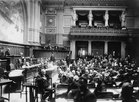
Unternavigation
On the occasion of the 1900 World Exhibition in Paris, social policymakers from various European countries founded the International Association for Labour Legislation (IALL). It established an International Labour Office in Basel that was largely funded by Switzerland. Just like the many other international congresses as well as international organisations and offices that emerged at the turn of the century, the foundation of the IALL reflected the growing economic interdependence of modern industrial countries and the development of modern transport and communication links. Matters of social security figured high on the international congress agenda. Experts and officials debated public welfare and private charity as well as occupational accidents, insurance schemes and the methods applied in actuarial science (for calculating insurance risks).
It was no coincidence that Switzerland was committed to workers’ protection beyond its borders. The Factory Act of 1877 contained special provisions for the protection of children and women, and was widely considered to be progressive. Representatives of the working class, industry and the Federal Council were all equally interested in harmonizing protection provisions the terms of competition across borders. After an initial diplomatic push failed in 1890, the workers’ union organized a congress in Zurich in 1897 that sought to coordinate international social policy.
After its foundation, the International Labour Office in Basel acted primarily as a documentation center. Further to its role as a private association close to government, the IALL initiated several conventions, including protection from hazardous substances and a ban of night work for women. Until the First World War, it continued to push for the protection of young workers and for the introduction of an eight-hour workday. Many of its functions were transferred to the International Labour Organization in 1919.
Literatur / Bibliographie / Bibliografia / References: Herren-Oesch Madeleine (2009), Internationale Organisationen seit 1865. Eine Globalgeschichte der internationalen Ordnung, Darmstadt; Topalov Christian (1999), Laboratoires du nouveau siècle. La nébuleuse réformatrice et ses réseaux en France, 1880-1914, Paris; Garamvölgyi Judit (1982), Die internationale Vereinigung für gesetzlichen Arbeiterschutz, in Gesellschaft und Gesellschaften. Festschrift Ulrich Im Hof, 626–646, Bern.
(12/2014)




